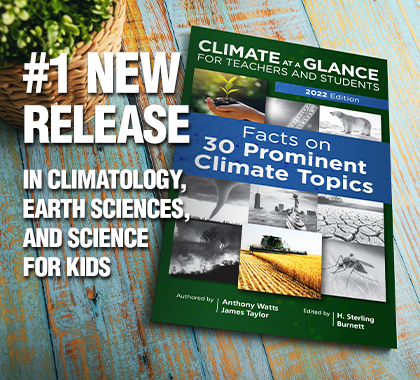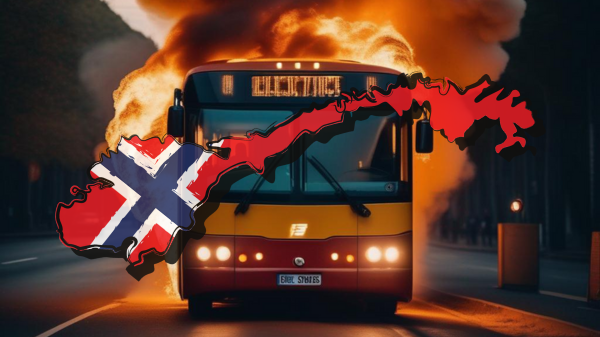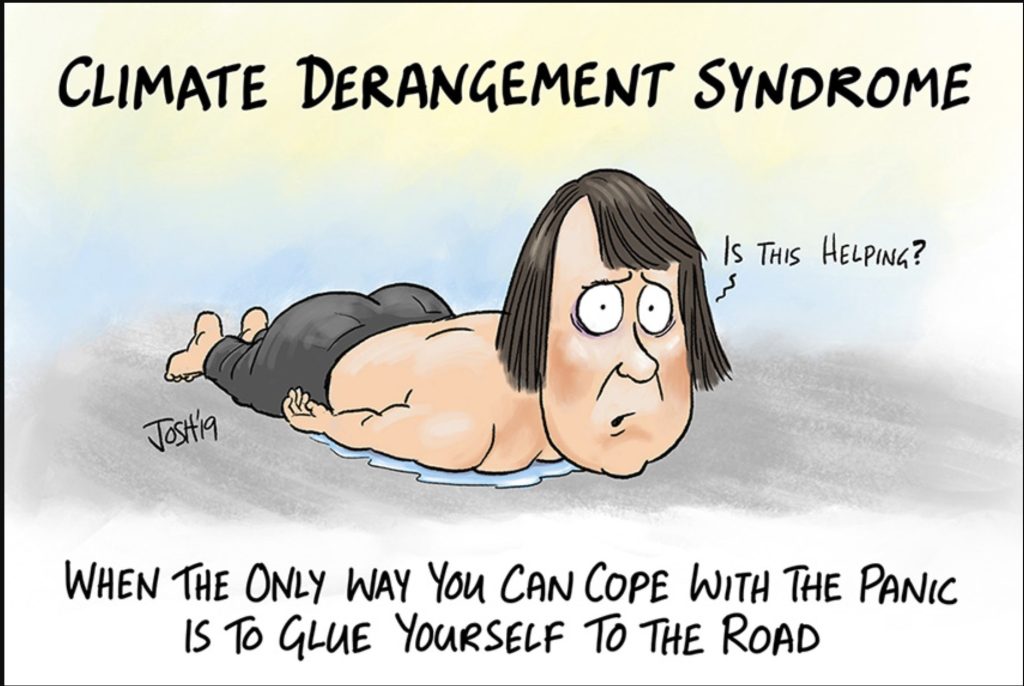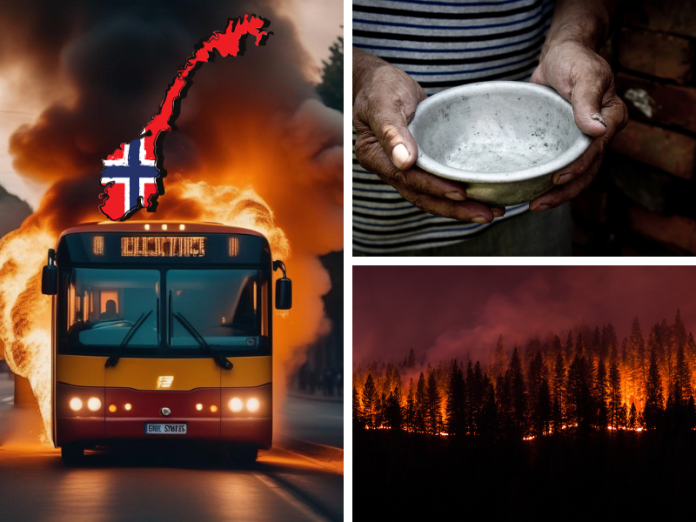YOU SHOULD SUBSCRIBE TO CLIMATE CHANGE WEEKLY.
IN THIS ISSUE:
- Climate Goals Undermining Global Poverty Reduction
- Podcast of the Week: UN Climate Conference Czars: You Need to Eat a Lot Less Meat
- Wildfires Well Below Seasonal Average
- Oslo Learns Hard Lesson About Electric Bus Performance in Cold Weather
- Climate Comedy
- Video of the Week: Cold Spells and The Polar Vortex | Climate at a Glance
- Recommended Sites
Miss Anything at Heartland’s Climate Conference? No Problem.

Climate Goals Undermining Global Poverty Reduction

Industry group Energy Transfer has gone on offense in a series of ads highlighting the critical importance of fossil fuels in everyday life. It’s about time the industry stopped playing defense. The ads, however, focus on how fossil fuels have created modern industrial societies. Not everyone has energy abundance. Much of the world suffers from energy poverty, which is largely why those regions suffer from abject penury, hunger, and preventable premature deaths.
Over the decades I’ve been working on climate change issues, I have discussed dozens of times how efforts to fight climate change by prematurely ending the use of fossil fuels harm the poor, in particular stunting much-desired economic development in the poorest nations on Earth, largely in Africa, Asia, and South and Central America. Fossil fuels are critical, for example, to modern 24/7 medical care and emergency services and to modern agriculture.
I’m not the only one who has noticed.
In an insightful and informed analysis, climatologist Judith Curry, Ph.D., author of the recent book Climate Uncertainty and Risk: Rethinking Our Response, shows efforts to limit carbon dioxide emissions and the target of “net zero” are undermining the U.N.’s stated goals of reducing poverty and expediting the economic development that provides the greatest hope for progress for the world’s poorest populations.
Curry begins by pointing to the obvious but often ignored good news: poverty, hunger, and premature mortality are lower than they have ever been, and lifespans are longer, largely because of the advancements made possible by fossil fuels:
100 years ago, the global population was 2 billion. Over the past century, the population has increased to 8 billion, life expectancy has more than doubled, a much smaller percent of the global population is living in poverty, global wealth has increased by a factor of 20, agricultural productivity and yields have increased substantially, and a far smaller fraction of the population die from extreme weather and climate events. …
And all this has occurred during a period where the global temperatures have increased by about 1oC.
Simultaneously, the world’s governments have set the goal of eliminating poverty and hunger and providing affordable energy as part of the United Nations’ “Sustainable Development Goals.” Those goals are at the top of the U.N.’s list, but they are being undermined, Curry points out, by climate goals lower down the list.
Indeed, Western elites’ push for net zero as the prime goal in development is driving decisions at international development banks created to reduce poverty and hampering efforts to alleviate hunger and poverty, Curry notes:
A recent UN Report on Progress Towards Sustainable Development Goals states
“Shockingly, the world is back at hunger levels not seen since 2005, and food prices remain higher in more countries than in the period 2015–2019.”
“At the current rate of progress, renewable energy sources will continue to account for a mere fraction of our energy supplies in 2030, some 660 million people will remain without electricity, and close to 2 billion people will continue to rely on polluting fuels and technologies for cooking.”
Neglecting these sustainability objectives in favor of rapidly reducing CO2 emissions is slowing down or even countering progress on the most important Sustainable Development Goals.
Efforts to rapidly restrict the use of fossil fuels is hampering the #1 goal of poverty reduction in Africa and is restricting Africa’s efforts to develop and utilize its own oil and gas resources (goal #7), as funds previously used for development are being redirected to CO2 mitigation (goal #13).
The #2 goal of no hunger is being hampered by food prices and availability are being worsened by climate mitigation efforts (goal #13), such as disincentives for fossil fuel development causing less supply and higher prices of fuels necessary for agriculture, biofuels (e.g. corn and seed oils), restrictions on livestock, and restrictions on fertilizer.
In the light of this, Curry reasonably asks,
Should one element of Goal 13, related to net-zero emissions, trump the higher priority goals of poverty and hunger and the availability of energy? Not if human well-being, flourishing and thriving are the objectives. Climate policy driven by the perceived urgency of eliminating fossil fuels and without regard to other needs and trade-offs is itself dangerous.
There are no rich, developed, industrialized countries that don’t also generate, produce, and/or use large amounts of energy, primarily fossil fuels. That is an easily verifiable fact.
Yet, at the behest of the U.N. and the Western governments that dominate it, development banks created to reduce poverty and advance economic development are doing just the opposite, in pursuit of net zero. Wealthier societies are less vulnerable to and more resilient in the face of natural disasters, including those caused by climate and weather. As a result, net zero efforts that prevent the use of fossil fuels critical for development are keeping the poorest populations vulnerable to such disasters. People are at more risk of harm than they would be if they used fossil fuels, even if such use is responsible for climate change, Curry writes:
[I]nternational funds for development are being redirected away from reducing poverty and increasing resilience, and towards reducing carbon emissions. By limiting development of electric power, this redirection is exacerbating the harms from weather hazards and climate change for the world’s poor. Development and poverty reduction require abundant and cheap energy, and natural gas is regarded as the best near-term solution for most countries. Working against this need in developing countries, UN Secretary-General António Guterres has called on countries to end all new fossil fuel exploration and production. The United Kingdom, the United States, and the European Union are aggressively limiting fossil fuel investments; the World Bank, the International Monetary Fund and other development banks are being pressured to do the same. The African Development Bank is increasingly unable to support large natural gas projects in the face of European shareholder pressure.
Limiting the development of fossil fuel projects is profoundly hampering development in Africa. Africa is starved for energy; sub-Saharan Africa’s one billion people have the power generation capacity that is less than the United Kingdom with 67 million people. …
Every dollar spent on reducing carbon emissions can have a significantly greater impact if directed into education, medical services, food security, and critical infrastructure.
And no, its not just liberty-loving Western climate “deniers” making these points. As Curry notes, African leaders and activists are raising objections to the Western world’s climate obsession undermining global poverty reduction efforts:
Leaders from developing countries have been outspoken in criticizing these changes in international funding practices. Ugandan President Yoweri Museveni warns that by pushing climate mitigation on African countries, the West will “forestall Africa’s attempts to rise out of poverty.”
A widely viewed Technology, Entertainment, Design (TED) Talk by Kenyan energy expert [and activist] Rose Mutiso characterized forcing emissions mitigation on the world’s poor that is widening economic inequality as equivalent to “energy apartheid.”
“Working in global energy and development, I often hear people say, ‘Because of climate, we just can’t afford for everyone to live our lifestyles,’” [Mutiso said]. “That viewpoint is worse than patronizing. It’s a form of racism, and it’s creating a two-tier global energy system, with energy abundance for the rich and tiny solar lamps for Africans.”
It’s time to end Western climate colonialism and allow poor nations to develop as we did, by using fossil fuels. The world can adapt to any adverse climate consequences of such a policy should they occur, as people have done throughout history.
Source: Climate Etc.
Get your Copy at Amazon TODAY!

Podcast of the Week
The other day, H. Sterling Burnett, director of The Heartland Institute’s Arthur B. Robinson Center on Climate and Environmental Policy, was on the John Steigerwald Show on AM1250 The Answer in Pittsburgh. He was invited on to talk about how the agenda of the United Nations’ annual climate conference — COP28 in Dubai — includes demanding everyone in the world eat less meat. To save the planet, of course.
Subscribe to the Environment & Climate News podcast on Apple Podcasts, iHeart, Spotify or wherever you get your podcasts. And be sure to leave a positive review!
Read the brutal truth about how battery production for electric vehicles cause immense environmental destruction and human tragedy.
Wildfires Well Below Seasonal Average

The National Interagency Fire Center reports the acreage lost to wildfires in 2023 was less than 40 percent of the average acreage lost annually for the previous 10 years. In fact, the approximately 2.6 million acres lost to wildfires in 2023 was the lowest total since 1998—35 years of global warming ago.
The sharp drop in wildfires was attributed mainly to a well-above-average year for precipitation in California, the Pacific Northwest, and the Mountain West, where wildfires are typically most prevalent.
Reporting on the mild wildfire year, meteorologist Paul Dorian writes,
One of the main contributing factors to the down year in overall US wildfire activity is the fact that it has been a mild year in California with the number of burned acres under 390,000 (as of 12/18). This value is down about 75% from the 5-year average of about 1.6 million acres burned in the Golden State. …
The weather during 2023 played an important role in keeping wildfire activity on the mild side across California. To begin, the winter of 2022-2023 brought very high precipitation amounts to the Golden State with record-breaking snow amounts at the higher elevations (e.g., Sierra Nevada). The melting of the snow this past summer season indeed lasted as late as ever in some spots helping to keep plenty of soil on the wet side across portions of California.
Other factors Dorian notes as suppressing wildfires in the West are cooler-than-average temperatures in wildfire-prone regions and the late-season tropical storm Hilary which delivered heavy rain to Southern California in what would normally be the height of wildfire season there.
Sources: Climate Depot, Arcfield/Weather
Heartland’s Must-read Climate Sites



Oslo Learns Hard Lesson About Electric Bus Performance in Cold Weather

Public transit is popular in Oslo, Norway, a city of about one million people. Nearly 240 million trips are taken annually on Oslo’s public transit system, according to the latest data from city transit, with bus travel making up the 49.03 percent of the trips taken.
As part of the city’s strategy to fight climate change, Oslo committed to electrifying its public transit system. Its rail systems, both metro and suburban, were already electric. In an effort to go fully electric with its public transit system, Oslo committed to replacing its diesel buses with an all-electric fleet. By 2023 the city had 200 electric buses on the streets, with a goal of replacing the final 400 diesel buses by the end of October.
The plans have hit a snag. Although many of the buses have been purchased and put into service and the diesel buses duly retired—at a premium of more than $250,000 per bus versus diesel buses—it turns out Oslo is not the ideal location for relying on electric buses, especially in winter, as any engineer or even any thinking person on the street might have anticipated.
Bild reports public transport has become paralyzed in Oslo because its shiny new electric buses are “not designed for these temperatures—their batteries are failing miserably in the icy cold.”
“The range of the electric buses decreases drastically in the cold,” reports Oslo’s public transportation operator. “The batteries run out more quickly.” More than 140 of the 183 new electric buses put into operation in April have been pulled from service because they ceased operating during cold weather, disrupting millions of commuters’ trips. Per Bild:
The new buses from Solaris were highly praised in advance and everything went well during the summer. But now, with the onset of winter, the weaknesses of the electric vehicles are becoming apparent: although a range of 250 kilometers is actually advertised, the buses sometimes simply break down.
Some news outlets tried to debunk the claim that Oslo’s electric buses are failing, despite videos showing the stalled buses and widespread reports of the breakdowns. However, even the experts Euronews interviewed noted cold weather created challenges for the buses:
According to Anna Stefanopoulou, at -12 Celsius, a parked EV can lose up to 30-40% of its range before it even starts its route.
About two-thirds of the extra energy consumed is used just to heat the inside of the car so it’s comfortable for the driver and passengers.
Electric vehicles … can’t draw on heat produced by the motor to warm the inside of the car.
They have to generate heat in other ways, hence using more energy from the battery which means losing in range.
… Professor Stefanopoulou believes it’s all a matter of organisation and planning.
“The buses need to stay plugged in, if possible, early on, before they start the route and stay plugged in overnight. When you do that, the battery can start and operate at this maximum range.”
“Then the transit authorities have to either adjust their routes and notify passengers or equip the bus with diesel heaters for these few cold months to make up for the 30% loss in range if they want to maintain a full schedule and their usual routes,” explained the battery expert.
But installing diesel engines means going against the zero-emission goal the city of Oslo is striving to achieve by 2024 for all of its public transportation.
Using diesel generators to heat buses defeats the purpose of going electric in the first place, and if the diesel heaters aren’t vented properly, it could create serious health harms.
Source: ASBZeitung; Euronews
Video of the Week
In the first of a new series based on The Heartland Institute’s Climate at a Glance for Teachers and Students, research fellow Linnea Lueken presents the facts about cold spells, the polar vortex, and their connection (or lack thereof) to global warming.
Climate Comedy
via Cartoons by Josh



























